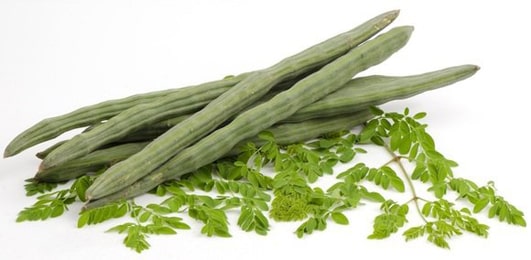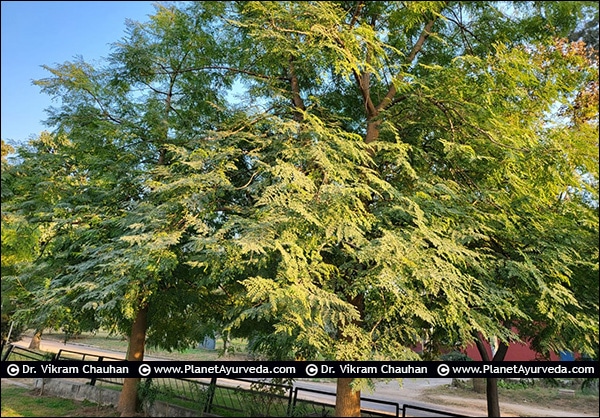Shigru, Drumstick (Moringa oleifera) – Properties, Benefits, Uses & Dosage

Description of Moringa Plant
Moringa (Moringa oleifera) is a graceful, small to medium-sized deciduous tree known for its nutritional and medicinal value. It typically grows to a height of 10–12 meters, with a trunk diameter of about 45 cm. The bark is smooth and dark grey, encased in a thick corky layer. Young shoots are either purple or greenish-white, often covered with fine hairs.
The tree has a deep taproot system and features a wide, open, and umbrella-shaped crown. Its leaves are tripinnate (divided three times), with rounded to elliptical leaflets that are dark green on the upper surface and pale beneath.
Flowers are produced throughout the year in favorable climates. These bisexual and fragrant flowers are borne in loose clusters and are characterized by five unequal, thinly veined petals, typically creamy white to yellowish in color.
The fruit is a long, hanging, three-sided capsule (pod), which turns brown when mature and contains numerous dark brown, round seeds. Each seed is equipped with three papery, wing-like structures, enabling dispersal by wind and air.
Moringa is often referred to as the “drumstick tree”, “miracle tree”, or “horseradish tree”, due to its high nutritional content, especially in the leaves, pods, and seeds, which are rich in vitamins, minerals, and antioxidants. It is widely used in traditional medicine and is known for its anti-inflammatory, antimicrobial, and nutrient-supplementing properties
Habitat
Shigru is basically native of India and wildly found in Sub Himalayan regions of northern India. Now it is grown in tropical and subtropical regions throughout the world. It is also found in Ethiopia, Sudan, Philippines, West East and South America, tropical Asia, Florida and pacific island.
Classification
- Kingdom – Plantae
- Order – Brassicales
- Family – Moringaceae
- Genus – Moringa
Names of Shigru
- Latin name – Moringa oleifera
- English name – Drumstick, Moringa, Horse radish tree
- Hindi name – Shigru, Sahijjan, Munaga
- Tamil name – Munagai
- Kannada name – Nugge mara, Nugge kayi
- Marathi name – Shevga
- Malayalam name – Muringa
- Sinhala name – Murunga
- Gujarati name – Saragyo
- Oriya name – Sujuna
- Punjabi name – Surjana
- Nepali name – Sajiwan
- Thai name – Ma rum
- Indonesian name – Kelor

Ayurvedic Properties of Shigru
| Hindi / Sanskrit | English | ||
| Rasa | Katu, Tikta | Taste | Pungent, Bitter |
| Guna | Laghu, Ruksha, Tikshna | Physical Property | Light, Dry, Sharp |
| Virya | Ushna | Potency | Hot |
| Vipaka | Katu | Metabolic Property (After Digestion) | Pungent |
Shigru Effects on Doshas
It balances Vata and Kapha doshas.
| Charak Samhita | Sushrut Samhita and vagbhata |
|
Varunadi gana |
Ancient verse about Moringa oleifera



1. According to first shalok : there are three types of shirgu:-
- Black sahijan (Shyam)
- White sahijan (Shweta)
- Red sahijan (Lal)
Shobhanjan, shigru, tikshanghandak, akshiv and mochak all are synonyms of shigru. Seeds of Shigru are called shweta marich. Red Shigru is called madhu Shigru. Shyam Shigru is sweet and pungent in taste, causing burning sensation, sharp, hot potency, sweet, light, rough and bitter in taste. It is used in sperm ejaculation, purgation, cardiac disorders, bleeding disorders and is good for eyes. It is used to cure abscess, inflammation, worm infestation, obesity, carbuncles, poisoning, splenomegaly, abdominal tumors, and lymphadenitis and to heal wounds. White Shigru possesses the same quality but it causes burning sensation and it is useful in splenic abscess, wounds, ulcers and bleeding disorders. Special properties of red type of Shigru is that it helps to stimulate digestion and it is a purgative.
2. According to the second shlok : Leaves and bark of shigru are used to reduce severe pain.
3. According to the third shlok : Shigru seeds are good for eyes, have hot potency and are sharp, do not have aphrodisiac properties, pacify kapha-vata and are used to cure poisoning. Seed powder is used in shirovirechna to cure severe headaches.
Practical uses of Moringa oleifera
- Moringa is an antioxidant herb. It protects our body from various infections and prevents our body from free radicals.
- Hypertension is one of the most serious problems nowadays. Moringa leaves powder and root bark are good for cardiac and circulatory system and it is used to reduce high blood pressure levels in the body.
- Drumstick fruit is known to increase the quality and quantity of sperms. It gives strength to male reproductive system.
- Moringa leaves, seeds and seeds pods are known for its anti-inflammatory nature. These are used to reduce inflammation. This Moringa leaves Powder is very beneficial in arthritis, rheumatism, cramps and gout.
- This herb also reduces high cholesterol levels and reduces the risk of heart diseases.
- Moringa seeds protect the body against harmful effects of arsenic toxicity.
- This herb is rich in calcium and magnesium and it improves the strength of teeth and bones. It is also used in osteoporosis and various bone disorders.
- Dried Moringa leaves are used for healthy and glowing skin.
- Leaves are rubbed over the forehead to relieve severe headache.
- It is applied over wounds and ulcers and due to its antibacterial and anti-inflammatory effects it helps in quick healing.
- Tea prepared from Moringa leaves is used to treat gastric ulcers and diarrhea.
- Seed powder of Moringa is used in scurvy and various skin infections.
- It is also antibiotic in nature and prevents body from sexually transmitted diseases and boils.
- Gum of this plant is diuretic, astringent, abortifacient and also very effective to treat asthma.
- Leaves are also very effective in bronchitis, fever, inflammation of mucous membrane and in eye and ear infections.
- It is used to pacify vata and kapha dosha.
Shigru Part used
- Moringa Leaves
- Moringa Seeds
- Moringa Fruits
- Moringa Flowers
- Moringa Bark
Shigru Dosage
- Powder – 1-3gm
- Decoction – 5-10ml



